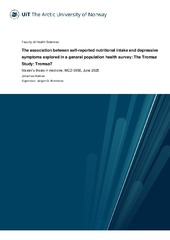The association between self-reported nutritional intake and depressive symptoms explored in a general population health survey: The Tromsø Study: Tromsø7
Author
Holmen, JohannesAbstract
Background:
Depression is a world health problem and therefore a subject of scientific interest. It not only affects individuals deeply but also places significant burden on healthcare systems worldwide. Research has suggested a possible link between nutrition and depressive symptoms, with certain nutrients receiving special attention in this context.
Material and method:
This is a cross-sectional study using data from The Tromsø Study: Tromsø7, a general population health study. A total of 21083 participants participated in the study whereas 21069 agreed to medical research. To measure depressive symptoms five questions from the HSCL-10 were included as part of this study. Nutritional intake was already calculated based on an extensive food frequency questionnaire filled out by participants. SPSS statistics was used for analyses exploring the association between depressive symptoms and nutritional intake. Linear regression analyses were run adjusted for and unadjusted for total energy intake. The data received was stored according to guidelines given by UiT.
Results:
Unadjusted for total energy intake HSCLdep showed positive associations with all nutritional variables. After adjusting for total energy intake HSCLdep showed positive associations with zinc (β = 0.047, p<0.001), as well as iron (β = 0.030, p<0.001) and fat (β = 0.021, p<0.001). Negative associations were seen between HSCLdep and phosphorus (β = -0.013, p<0.001), as well as carbohydrate (β = -0.014, p<0.001).
Conclusion:
This cross-sectional study using data from The Tromsø Study: Tromsø7 found that depressive symptoms were positively associated with energy, fat, iron and zinc, and inversely associated with carbohydrate and phosphorus intake. More women and younger individuals scored above the HSCL cut-off. Some findings contrast with previous studies, maybe because of the healthy population sample and the fact that we examined a range of depressive symptoms rather than the clinical diagnosis of depression. This study offers insight into nutrition and mental health, but further longitudinal and intervention studies are needed. Background:
Depression is a world health problem and therefore a subject of scientific interest. It not only affects individuals deeply but also places significant burden on healthcare systems worldwide. Research has suggested a possible link between nutrition and depressive symptoms, with certain nutrients receiving special attention in this context.
Material and method:
This is a cross-sectional study using data from The Tromsø Study: Tromsø7, a general population health study. A total of 21083 participants participated in the study whereas 21069 agreed to medical research. To measure depressive symptoms five questions from the HSCL-10 were included as part of this study. Nutritional intake was already calculated based on an extensive food frequency questionnaire filled out by participants. SPSS statistics was used for analyses exploring the association between depressive symptoms and nutritional intake. Linear regression analyses were run adjusted for and unadjusted for total energy intake. The data received was stored according to guidelines given by UiT.
Results:
Unadjusted for total energy intake HSCLdep showed positive associations with all nutritional variables. After adjusting for total energy intake HSCLdep showed positive associations with zinc (β = 0.047, p<0.001), as well as iron (β = 0.030, p<0.001) and fat (β = 0.021, p<0.001). Negative associations were seen between HSCLdep and phosphorus (β = -0.013, p<0.001), as well as carbohydrate (β = -0.014, p<0.001).
Conclusion:
This cross-sectional study using data from The Tromsø Study: Tromsø7 found that depressive symptoms were positively associated with energy, fat, iron and zinc, and inversely associated with carbohydrate and phosphorus intake. More women and younger individuals scored above the HSCL cut-off. Some findings contrast with previous studies, maybe because of the healthy population sample and the fact that we examined a range of depressive symptoms rather than the clinical diagnosis of depression. This study offers insight into nutrition and mental health, but further longitudinal and intervention studies are needed.
Publisher
UiT The Arctic University of NorwayMetadata
Show full item recordCollections
- Mastergradsoppgaver Helsefak [1337]
Copyright 2025 The Author(s)


 English
English norsk
norsk
